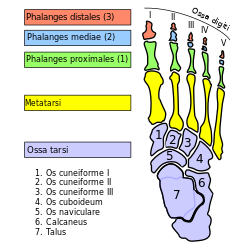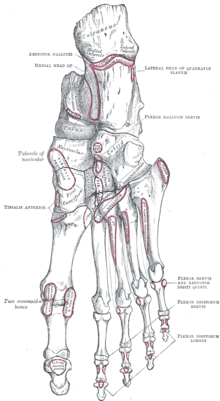This is an old revision of this page, as edited by Clarinetguy097 (talk | contribs) at 02:43, 23 July 2015 (→Size: etymology is covered elsewhere). The present address (URL) is a permanent link to this revision, which may differ significantly from the current revision.
Revision as of 02:43, 23 July 2015 by Clarinetguy097 (talk | contribs) (→Size: etymology is covered elsewhere)(diff) ← Previous revision | Latest revision (diff) | Newer revision → (diff) This article is about the body part. For other uses, see Toe (disambiguation).| Toes | |
|---|---|
 Toes on the foot. The innermost toe (bottom-left in image), which is normally called the big toe, is the hallux. Toes on the foot. The innermost toe (bottom-left in image), which is normally called the big toe, is the hallux. | |
 Bones of the foot (the toe bones are the ones in green, blue and orange) Bones of the foot (the toe bones are the ones in green, blue and orange) | |
| Details | |
| Identifiers | |
| Latin | Digiti pedis |
| MeSH | D014034 |
| TA98 | A01.1.00.046 |
| TA2 | 170 |
| FMA | 25046 |
| Anatomical terminology[edit on Wikidata] | |
Toes are the digits of the foot of a tetrapod. Animal species such as cats that walk on their toes are described as being digitigrade. Humans, and other animals that walk on the soles of their feet, are described as being plantigrade; unguligrade animals are those that walk on hooves at the tips of their toes.
Structure

The toe refers to a part of the human foot, with five toes present on each human foot. Each toe consists of three phalanx bones, the proximal, middle, and distal, with the exception of the big toe (Template:Lang-la). The hallux only contains two phalanx bones, the proximal and distal. The phalanx bones of the toe join to the metatarsal bones of the foot at the interphalangeal joints. Outside the hallux bones is skin, and present on all five toes is a toenail.
The toes are, from medial to lateral:
- The first toe, also known as the hallux ("big toe" or "great toe"), the innermost toe
- The second toe, or "long toe"
- The third toe, or "middle toe"
- The fourth toe, or "ring toe"
- The fifth toe, "little toe", "pinky toe", or "baby toe", the outermost toe.
Muscles
See also: Foot § MusclesToe movement is generally flexion and extension via muscular tendons that attach to the toes on the anterior and superior surfaces of the phalanx bones.
With the exception of the hallux, toe movement is generally governed by action of the flexor digitorum brevis and extensor digitorum brevis muscles. These attach to the sides of the bones, making it impossible to move individual toes independently. Muscles between the toes on their top and bottom also help to bring abduct and adduct the toes. The hallux and little toe have unique muscles:
- The hallux is primarily flexed by the flexor hallucis longus muscle, located in the deep posterior of the lower leg, via the flexor hallucis longus tendon. Additional flexion control is provided by the flexor hallucis brevis. It is extended by the abductor hallucis muscle and the adductor hallucis muscle.
- The little toe has a separate set of control muscles and tendon attachments, the flexor and abductor digiti minimi. Numerous other foot muscles contribute to fine motor control of the foot. The connective tendons between the minor toes accounts for the inability to actuate individual toes.
Blood supply
The toes receive blood from the digital branches of the plantar metatarsal arteries and drain blood into the dorsal venous arch of the foot.
Innervation
Sensation to the skin of the toes is provided by five nerves. The superficial fibular nerve supplies sensation to the top of the toes, except between the hallux and second toe, which is supplied by the deep fibular nerve, and the outer surface of the fifth toe, supplied by the sural nerve. Sensation to the bottom of the toes is supplied by the medial plantar nerve, which supplies sensation to the great toe and inner three-and-a-half toes, and the lateral plantar nerve, which supplies sensation to the little toe and half of the sensation of the fourth toe.
Size
See also: Digit ratio
In humans, the hallux is usually longer than the second toe, but in some individuals, it may not be the longest toe. There is an inherited trait in humans, where the dominant gene causes a longer second toe ("Morton's toe" or "Greek foot") while the homozygous recessive genotype presents with the more common trait: a longer hallux. People with the rare genetic disease fibrodysplasia ossificans progressiva characteristically have a short hallux which appears to turn inward, or medially, in relation to the foot.
The fifth toe is the outermost, and usually the smallest, toe of the foot.
Variation
Humans usually have five toes on each foot. When more than five toes are present, this is known as polydactyly. Other variants may include syndactyly or amputation.
Forefoot shape, including toe shape, exhibits significant variation among people; these differences can be measured and have been statistically correlated with ethnicity. Such deviations may affect comfort and fit for various shoe types. Research conducted by Freedman for the U.S. Army indicated that larger feet may still have smaller arches, toe length, and toe-breadth.
Function
The human foot consists of multiple bones and soft tissues which support the weight of the upright human. Specifically, the toes assist the human while walking, providing balance, weight-bearing, and thrust during the gait.
Clinical relevance
A sprain or strain to the small interphalangeal joints of the toe is commonly called a stubbed toe. A sprain or strain where the toe joins to the foot is called turf toe.
Long-term use of improperly sized shoes can cause misalignment of toes, as well as other orthopedic problems.
Morton's neuroma commonly results in pain and numbness between the third and fourth toes of the sufferer, due to it affecting the nerve between the third and fourth metatarsal bones.
The big toe is also the most common locus of ingrown nails and gout attacks.
Deformity
Main articles: Hammer toe and BunionDeformities of the foot include hammer toe, trigger toe, and claw toe. Hammer toe can be described as an abnormal contraction or “buckling” of a toe. This is done by a partial or complete dislocation of one of the joints, which form the toes. Since the toes are deformed further, these may press against a shoe and cause pain. Deformities of the foot can also be caused by rheumatoid arthritis and diabetes mellitus. Deformities may predispose to ulcers and pain, especially when shoe-wearing.
A common problem involving the big toe is the formation of bunions. These are structural deformities of the bones and the joint between the foot and big toe, and may be painful. Similar deformity involving the fifth toe is described as tailor's bunion or bunionette.
In reconstruction
A favourable option for the reconstruction of missing adjacent fingers/multiple digit amputations, i.e. such as a metacarpal hand reconstruction, is to have a combined second and third toe transplantation. Third and fourth toe transplantation are also good.
History
Etymology
- Ta
The Old English term for toe is ta (plural tan). This is a contraction of tahe, and derives from Proto-Germanic taihwo (cognates: Old Norse ta, Old Frisian tane, Middle Dutch te, Dutch teen (perhaps originally a plural), Old High German zecha, German Zehe). Perhaps originally meaning "fingers" as well (many Proto-Indo-European language (PIE) languages still use one word to mean both fingers and toes), and thus from PIE root deik — "to show".
- Hallux
In classical Latin hallex, allex, hallus and allus, with genitive (h)allicis and (h)alli, are used to refer to the big toe. The form hallux (genitive, hallucis) currently in use is however a blend word of the aforementioned forms. Compare pollex, the equivalent term for the thumb.
In other animals
In birds with anisodactyl or heterodactyl feet, the hallux is opposed or directed backwards and allows for grasping and perching.
While the thumb is often mentioned as one of the signature characteristics in humans, this manual digit remains partially primitive and is actually present in all primates. In humans, the most derived digital feature is the hallux.
See also
This article uses anatomical terminology.- Ainhum
- Finger, for the hand digits
- Morton's toe
- Nail (anatomy)
- Polydactyly and Syndactyly
- Runner's toe
- Toe cleavage
- Toe tag
- Webbed toes
- Toecuffs
References
- ^ Drake, Richard L.; Vogl, Wayne; Tibbitts, Adam W.M. Mitchell; illustrations by Richard; Richardson, Paul (2005). Gray's anatomy for students. Philadelphia: Elsevier/Churchill Livingstone. ISBN 978-0-8089-2306-0.
- Online Mendelian Inheritance in Man (OMIM): Toes — relative lengths of first and second - 189200
- Hawes, MR; Sovak, D; Miyashita, M; Kang, SJ; Yoshihuku, Y; Tanaka, S (Jan 1994). "Ethnic differences in forefoot shape and the determination of shoe comfort". Ergonomics. 37 (1): 187–96. doi:10.1080/00140139408963637. PMID 8112275.
- Freedman, A., Huntington, E.C., Davis, G.C., Magee, R.B., Milstead, V.M. and Kirkpatrick, C.M.. 1946. Foot Dimensions of Soldiers (Third Partial Report), Armored Medical Research Laboratory, Fort Knox, Kentucky.
- Janey Hughes, Peter Clark, & Leslie Klenerman. The Importance of the Toes in Walking. The Journal of Bone and Joint Surgery, Vol. 72-B, No. 2. March, 1990.
- "Morton's Neuroma". Retrieved August 21, 2012.
- American College of Foot and Ankle Surgeons. "Bunions". Retrieved 2008-03-05.
- Wei, Fu-Chan; Colony, Lee H.; Chen, Hung-Chi; Chuang, Chwei-Chin; Noordhoff, Samuel M. (1989). "Combined Second and Third Toe Transfer". Plastic and Reconstructive Surgery. 84 (4): 651–61. doi:10.1097/00006534-198984040-00016. PMID 2780906.
- Cheng, Ming-Huei; Wei, Fu-Chan; Santamaria, Eric; Cheng, Shao-Lung; Lin, Chih-Hung; Chen, Samuel H. T. (1998). "Single versus Double Arterial Anastomoses in Combined Second- and Third-Toe Transplantation". Plastic & Reconstructive Surgery. 102 (7): 2408. doi:10.1097/00006534-199812000-00021.
- Lutz, Barbara S.; Wei, Fu-Chan (2002). "Basic Principles on Toe-to-Hand Transplantation" (PDF). Gung Medical Journal. 25 (9): 568–76. PMID 12479617.
- "Online Etymology Dictionary". Toe.
- ^ Hyrtl, J. (1880). Onomatologia Anatomica. Geschichte und Kritik der anatomischen Sprache der Gegenwart. Wien: Wilhelm Braumüller. K.K. Hof- und Unversitätsbuchhändler.
- Triepel, H. (1908). Memorial on the anatomical nomenclature of the anatomical society. In A. Rose (Ed.), Medical Greek. Collection of papers on medical onomatology and a grammatical guide to learn modern Greek (pp. 176-193). New York: Peri Hellados publication office.
- Lewis, C.T. & Short, C. (1879). A Latin dictionary founded on Andrews' edition of Freund's Latin dictionary. Oxford: Clarendon Press.
- Triepel, H. (1910). Die anatomischen Namen. Ihre Ableitung und Aussprache. Mit einem Anhang: Biographische Notizen.(Dritte Auflage). Wiesbaden: Verlag J.F. Bergmann.
- Lovejoy, C. Owen; Suwa, Gen; Simpson, Scott W.; Matternes, Jay H. (October 2009). "The Great Divides: Ardipithecus ramidus Reveals the Postcrania of Our Last Common Ancestors with African Apes". Science. 326 (5949): 102. doi:10.1126/science.1175833. PMID 19810199.
{{cite journal}}: Invalid|ref=harv(help); Unknown parameter|coauthors=ignored (|author=suggested) (help)
| Human regional anatomy | |||||
|---|---|---|---|---|---|
| Body | Skin | ||||
| Head | |||||
| Neck | |||||
| Torso (Trunk) | |||||
| Limbs |
| ||||